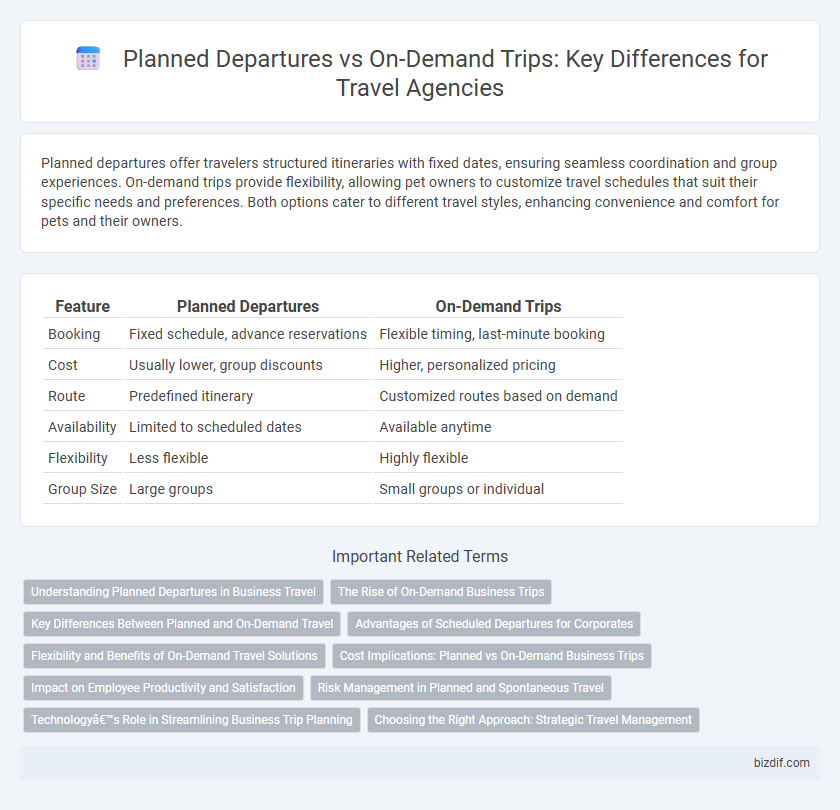Planned departures offer travelers structured itineraries with fixed dates, ensuring seamless coordination and group experiences. On-demand trips provide flexibility, allowing pet owners to customize travel schedules that suit their specific needs and preferences. Both options cater to different travel styles, enhancing convenience and comfort for pets and their owners.
Table of Comparison
| Feature | Planned Departures | On-Demand Trips |
|---|---|---|
| Booking | Fixed schedule, advance reservations | Flexible timing, last-minute booking |
| Cost | Usually lower, group discounts | Higher, personalized pricing |
| Route | Predefined itinerary | Customized routes based on demand |
| Availability | Limited to scheduled dates | Available anytime |
| Flexibility | Less flexible | Highly flexible |
| Group Size | Large groups | Small groups or individual |
Understanding Planned Departures in Business Travel
Planned departures in business travel involve pre-scheduled flights or trips organized well in advance, ensuring availability, fixed pricing, and streamlined itinerary management. These departures enable companies to secure preferred accommodations and transportation, optimizing cost control and employee productivity. Compared to on-demand trips, planned departures reduce last-minute expenses and logistical complexities, enhancing overall travel efficiency for corporate clients.
The Rise of On-Demand Business Trips
On-demand business trips have surged due to increased flexibility and immediate travel needs in the corporate world, contrasting with traditional planned departures scheduled weeks or months in advance. This shift allows companies to respond swiftly to dynamic market conditions, enhancing productivity and reducing downtime. The travel industry adapts by offering customizable itineraries, seamless booking platforms, and real-time adjustments to meet the growing demand for spontaneous corporate travel solutions.
Key Differences Between Planned and On-Demand Travel
Planned departures involve fixed schedules, pre-arranged itineraries, and group bookings, optimizing cost-efficiency and ensuring availability for popular destinations. On-demand trips offer flexibility with customizable timing, personalized routes, and spontaneous booking, catering to travelers seeking unique and tailored experiences. Key differences include the level of control over travel plans, pricing structures, and adaptability to last-minute changes.
Advantages of Scheduled Departures for Corporates
Scheduled departures offer corporates reliable timelines and fixed itineraries, enabling efficient planning and budget allocation. These prearranged trips streamline group coordination, reduce uncertainty, and often provide cost savings through negotiated rates and bulk booking advantages. Corporates benefit from predictable travel schedules that enhance productivity and minimize disruptions during business operations.
Flexibility and Benefits of On-Demand Travel Solutions
On-demand travel solutions offer unmatched flexibility compared to planned departures by allowing travelers to customize their itineraries and departure times based on personal preferences and real-time availability. This approach reduces waiting times and eliminates rigid schedules, making it ideal for last-minute plans or spontaneous trips. Benefits of on-demand travel include cost-efficiency, personalized experiences, and enhanced convenience, appealing to modern travelers seeking adaptable and stress-free journeys.
Cost Implications: Planned vs On-Demand Business Trips
Planned departures typically offer lower costs due to advanced booking discounts, bulk purchasing, and fixed itineraries that optimize resource allocation. On-demand trips, while flexible to meet urgent travel needs, often incur higher expenses from last-minute bookings, premium fares, and limited availability. Strategic planning in travel agencies enables cost savings by balancing bulk deals with occasional on-demand requests for business trips.
Impact on Employee Productivity and Satisfaction
Planned departures streamline workflow, enabling travel agency employees to optimize schedules and resource allocation, which enhances productivity and reduces stress. On-demand trips require rapid responsiveness and adaptability, increasing workload variability but fostering skill development and job engagement. Balancing both trip types can lead to improved employee satisfaction by offering structured routines alongside dynamic challenges.
Risk Management in Planned and Spontaneous Travel
Planned departures allow travel agencies to implement comprehensive risk management strategies through advance coordination of accommodations, transportation, and safety protocols, minimizing unforeseen disruptions. In contrast, on-demand trips require agile risk mitigation techniques, leveraging real-time data and flexible contingencies to address spontaneous changes and emergencies. Both modes necessitate robust communication systems to ensure traveler safety and swift response in dynamic environments.
Technology’s Role in Streamlining Business Trip Planning
Technology enhances efficiency in travel agencies by enabling seamless management of planned departures and on-demand trips through integrated platforms and real-time data analytics. Automated scheduling tools and AI-driven itinerary customization reduce operational costs and improve customer satisfaction by delivering personalized, timely travel options. Cloud-based solutions facilitate dynamic adjustments and instant communication, optimizing the entire business trip planning process.
Choosing the Right Approach: Strategic Travel Management
Choosing the right approach between planned departures and on-demand trips is crucial for strategic travel management, balancing cost-efficiency and flexibility. Planned departures enable bulk booking discounts and streamlined logistics, while on-demand trips cater to dynamic itineraries and spontaneous traveler needs. Effective travel agencies leverage data analytics to optimize trip scheduling, ensuring maximum resource utilization and enhanced traveler satisfaction.
Planned departures vs On-demand trips Infographic

 bizdif.com
bizdif.com